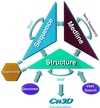MMDB: 3D structure data in Entrez
- PMID: 10592236
- PMCID: PMC102448
- DOI: 10.1093/nar/28.1.243
MMDB: 3D structure data in Entrez
Abstract
Three-dimensional structures are now known for roughly half of all protein families. It is thus quite likely, in searching sequence databases, that one will encounter a homolog with known structure and be able to use this information to infer structure-function properties. The goal of Entrez's 3D structure database is to make this information accessible and useful to molecular biologists. To this end, Entrez's search engine provides three powerful features: (i) Links between databases; one may search by term matching in Medline((R)), for example, and link to 3D structures reported in these articles. (ii) Sequence and structure neighbors; one may select all sequences similar to one of interest, for example, and link to any known 3D structures. (iii) Sequence and structure visualization; identifying a homolog with known structure, one may view a combined molecular-graphic and alignment display, to infer approximate 3D structure. Entrez's MMDB (Molecular Modeling DataBase) may be accessed at: http://www.ncbi.nlm.nih.gov/Entrez/structure.html
Figures


References
Publication types
MeSH terms
LinkOut - more resources
Full Text Sources
Other Literature Sources

